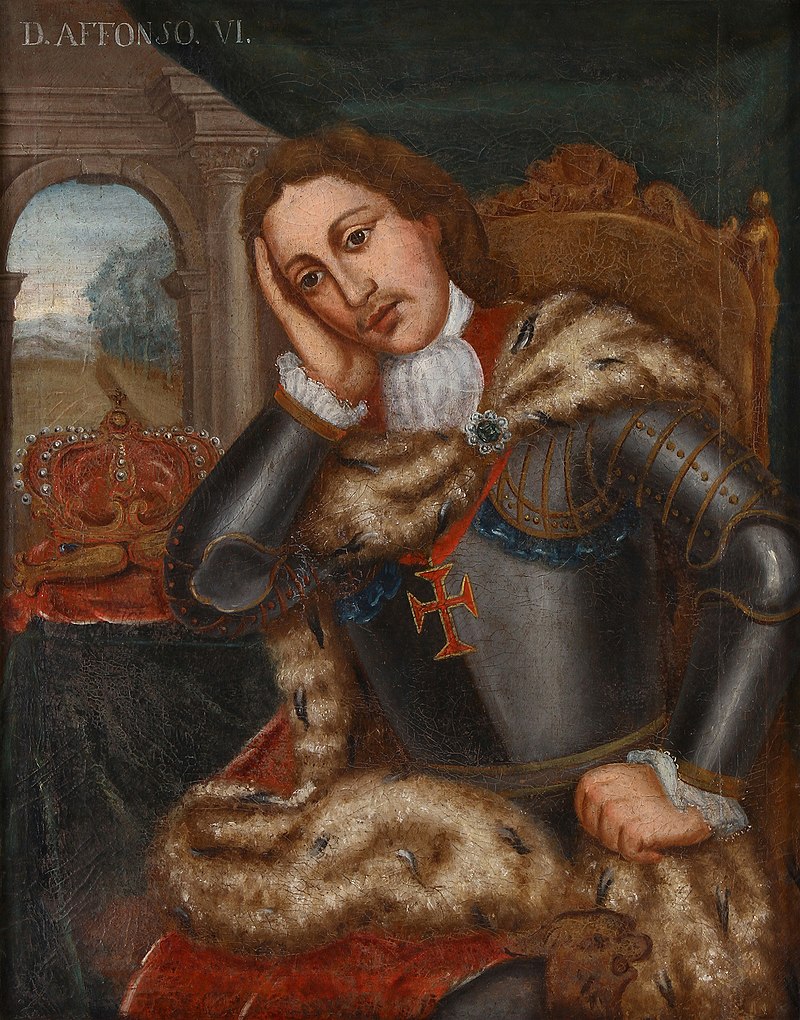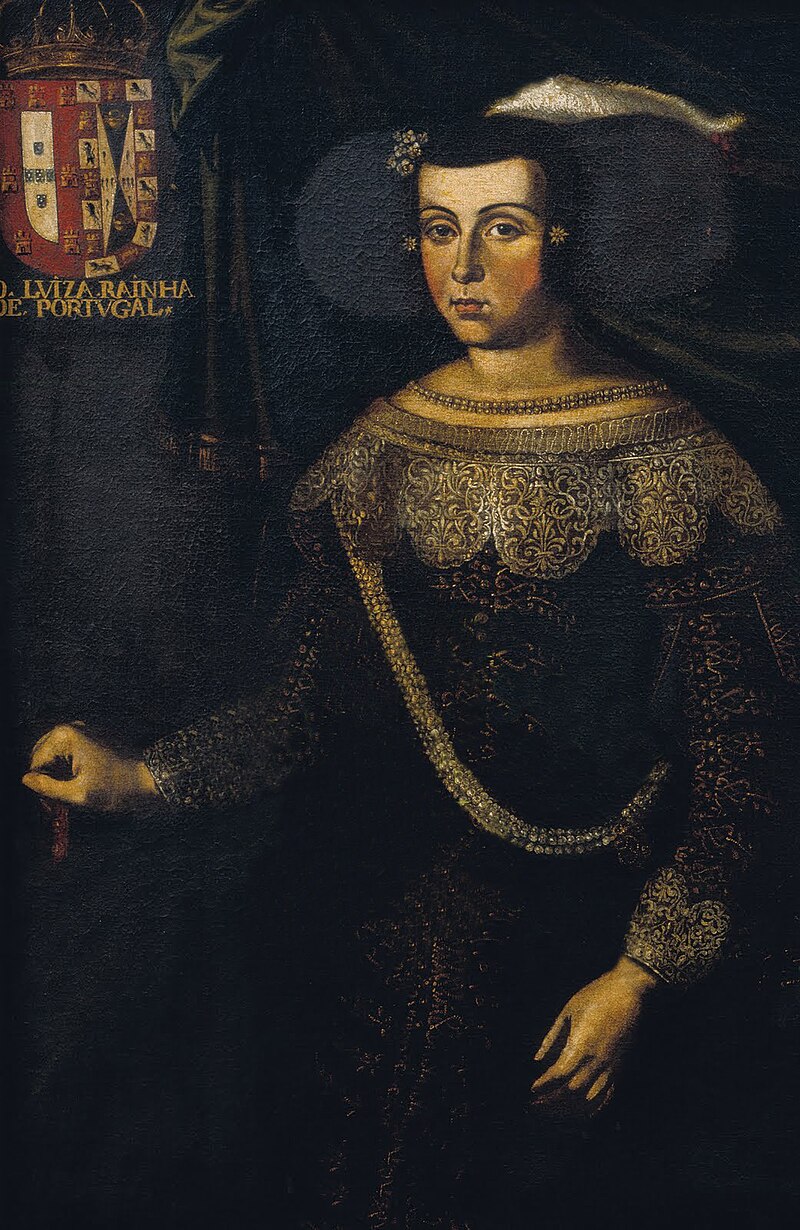by Susan Flantzer
© Unofficial Royalty 2022

Afonso VI, King of Portugal; Credit – Wikipedia
Debilitated mentally and physically due to the effects of a disease he contracted in childhood, controlled by a favorite early in his reign, relieved of his sovereign power by his brother who married his wife after their marriage was annulled, and confined under guard for the last fifteen years of his life, Afonso VI, King of Portugal was born on August 21, 1643, at Ribeira Palace in Lisbon, Portugal. He was the sixth of the seven children and the third but the second surviving of the four sons of João IV, King of Portugal and Luisa de Guzmán y Sandoval. Catherine of Braganza who married Charles II, King of England and King of Scots, was Afonso’s sister. His paternal grandparents were the Portuguese nobleman Teodósio II, 7th Duke of Braganza and the Spanish noblewoman Ana de Velasco y Téllez-Girón. Afonso’s maternal grandparents were the Spanish nobles Juan Manuel Pérez de Guzmán y Silva, 8th Duke of Medina Sidonia and Juana Lorenza Gomez de Sandoval y de la Cerda.

A childhood portrait of Afonso’s sister Catherine of Braganza, who married King Charles II of England; Credit – Wikipedia
Afonso had six siblings:
- Teodósio, Prince of Brazil, Duke of Braganza (1634 – 1653), died at age 19 due to tuberculosis
- Ana of Braganza (born and died 1635), died at birth
- Joana of Braganza, Princess of Beira (1635 – 1653), died in her teens
- Catherine of Braganza, Queen of England, Queen of Scots (1638 – 1705), married Charles II, King of England, King of Scots, no children, had at least three miscarriages
- Manuel of Portugal (born and died 1640), died at birth
- Pedro II, King of Portugal (1648 – 1706), married (1) Maria Francisca of Savoy, had one daughter (2) married Maria Sophia of Neuburg, had eight children
At the time of his birth, Afonso was second in the line of succession to the Portuguese throne after his brother Teodósio who was nine years older. When Afonso was about three years old, he had a “malignant fever” that affected the right side of his body and left him physically and mentally challenged. Today, it is suspected that he had a disease of the central nervous system, perhaps meningoencephalitis. Meningoencephalitis can cause permanent neurological damage including memory difficulty, learning disabilities, brain damage, and gait problems, and Afonso appears to have had those issues. As he was the second son and was also mentally challenged, Afonso was not prepared to be king. However, on May 13, 1653, Afonso’s eldest brother Teodósio died at age 19 due to tuberculosis and Afonso became heir to the throne of Portugal.

Afonso’s mother Luisa who served as his regent; Credit – Wikipedia
Afonso’s father João IV, King of Portugal died on November 6, 1656, aged 52. Afonso was only thirteen years old when he succeeded his father. João IV had appointed his wife Luisa as the regent during the minority of their son Afonso VI. During her years as Regent of Portugal, Luisa defended the independence of Portugal and was responsible for the diplomatic success of the new alliance with England which included the marriage of her daughter Catherine to Charles II, King of England and King of Scots.

Afonso’s favorite Luís de Vasconcelos e Sousa, 3rd Count of Castelo Melhor; Credit – Wikipedia
Luisa appointed Luís de Vasconcelos e Sousa, 3rd Count of Castelo Melhor as one of Afonso’s gentlemen of the bedchamber. However, this appointment would work against Luisa and ultimately remove her from her power position. Because Afonso was physically and mentally challenged, his mother Luisa wanted to continue as regent after he reached the age of majority in November 1662. However, shortly after Afonso VI reached the age of majority, Luís de Vasconcelos e Sousa, 3rd Count of Castelo Melhor, who was seven years older than Afonso, saw an opportunity to gain power. Becoming Afonso’s favorite, Castelo Melhor convinced Afonso that his mother Luisa was planning to steal his throne and exile him from Portugal, although there was no evidence that this was true. As a result, Afonso took control of the throne and appointed Castelo Melhor his escrivão da puridade (scribe of purity), a position that enabled Castelo Melhor to exercise the functions of a prime minister. Luisa remained in the palace until March 1663, when she retired to the Discalced Carmelite convent in Xabregas, Lisbon, Portugal. She died there three years later.
The Portuguese government was split between a pro-French faction led by Luís de Vasconcelos e Sousa, 3rd Count of Castelo Melhor, and a pro-English faction led by Afonso’s brother Pedro. In 1662, Afonso’s sister Catherine had married King Charles II of England. Castelo Melhor and King Louis XIV of France saw a French marriage for Afonso as a way to offset his sister’s English marriage.

Afonso’s wife Marie Françoise of Savoy; Credit – Wikipedia
The chosen bride for Afonso was Marie Françoise of Savoy, daughter of French military leader Charles Amadeus of Savoy, Duke of Nemours, and Élisabeth de Bourbon-Vendôme, a granddaughter of King Henri IV of France and his mistress Gabrielle d’Estrées. Marie Françoise of Savoy arrived in Portugal on August 2, 1666. The wedding took place the same day and Marie Françoise became known as Maria Francisca. Problems with the marriage began to occur immediately after the wedding ceremony. Afonso left the wedding celebrations early and showed no interest in consummating the marriage. Maria Francisca was intelligent and wanted to serve the French interests but she also wanted power. She soon discovered Afonso was controlled by Castelo Melhor who had no intention of sharing power. This caused her to cooperate with her brother-in-law Pedro and his pro-English faction, and then most likely, she began an affair with him. Maria Francisca persuaded King Louis XIV of France that supporting Pedro was a better way to further French interests.

Afonso’s brother, the future Pedro II, King of Portugal; Credit – Wikipedia
Soon Luís de Vasconcelos e Sousa, 3rd Count of Castelo Melhor and his pro-France faction were losing ground to Pedro, Maria Francisca, and their pro-English faction. After a palace coup led by Pedro and Maria Francisca, Afonso VI was forced to dismiss Castelo Melhor who went into exile and was not permitted to return to Portugal until 1685. Pedro assumed the role of Prince Regent in 1668. While Pedro never formally usurped the throne, Afonso was king in name only for the rest of his life. Maria Francisca retired temporarily to a convent and asked the Roman Catholic Church to annul her marriage on the grounds of non-consummation. This was approved by her uncle Louis de Bourbon, Cardinal Vendôme. Maria Francisca and Pedro were married on April 2, 1668, after receiving a papal bull authorizing the marriage.

Afonso VI imprisoned in the Palace of Sintra by Alfredo Roque Gameiro, 1917; Credit – Wikipedia
Afonso was exiled to Terceira Island in the Azores. In 1673, a conspiracy to restore Afonso to the throne was discovered and squelched. A decision was made to return Afonso to Lisbon where he could be better monitored. Afonso arrived in Lisbon on September 14, 1674, and was taken to the Palace of Sintra in Lisbon. For the rest of his life, he lived there, under guard and shut up in his quarters.

The Royal Pantheon of the House of Braganza, the burial site for members of the House of Braganza, at the Monastery of São Vicente de Fora. Afonso’s tomb is against the wall with the window on the top right; Credit – Por Alegna13 – Obra do próprio, CC BY-SA 3.0, https://commons.wikimedia.org/w/index.php?curid=16664413
On September 12, 1683, 40-year-old Afonso suffered a stroke and died later the same day. He was interred in the Royal Pantheon of the House of Braganza, the burial site for members of the House of Braganza, at the Monastery of São Vicente de Fora in Lisbon, Portugal. Afonso’s brother succeeded him as Pedro II, King of Portugal, and Maria Francisca was Queen of Portugal for a second time.
This article is the intellectual property of Unofficial Royalty and is NOT TO BE COPIED, EDITED, OR POSTED IN ANY FORM ON ANOTHER WEBSITE under any circumstances. It is permissible to use a link that directs to Unofficial Royalty.
Works Cited
- En.wikipedia.org. 2022. Afonso VI of Portugal – Wikipedia. [online] Available at: <https://en.wikipedia.org/wiki/Afonso_VI_of_Portugal> [Accessed 27 May 2022].
- En.wikipedia.org. 2022. Maria Francisca of Savoy – Wikipedia. [online] Available at: <https://en.wikipedia.org/wiki/Maria_Francisca_of_Savoy> [Accessed 27 May 2022].
- Flantzer, Susan, 2022. João IV, King of Portugal. [online] Unofficial Royalty. Available at: <https://www.unofficialroyalty.com/joao-iv-king-of-portugal/> [Accessed 27 May 2022].
- Flantzer, Susan, 2022. Luisa de Guzmán, Queen of Portugal. [online] Unofficial Royalty. Available at: <https://www.unofficialroyalty.com/luisa-de-guzman-queen-of-portugal/> [Accessed 27 May 2022].
- Louda, Jiri and Maclagan, Michael, 2002. Lines of Succession. London: Little, Brown.
- Pt.wikipedia.org. 2022. Afonso VI de Portugal – Wikipédia, a enciclopédia livre. [online] Available at: <https://pt.wikipedia.org/wiki/Afonso_VI_de_Portugal> [Accessed 27 May 2022].
- Pt.wikipedia.org. 2022. Maria Francisca de Saboia, Rainha de Portugal – Wikipédia, a enciclopédia livre. [online] Available at: <https://pt.wikipedia.org/wiki/Maria_Francisca_de_Saboia,_Rainha_de_Portugal> [Accessed 27 May 2022].
